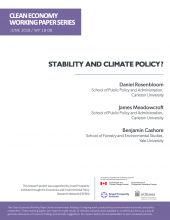June 20, 2019
The transition to a low-carbon economy will require changes at every level of society, from investment in clean innovation and the widespread deployment of resulting green technologies, to behaviour changes and new environmental policies. Achieving this low-carbon Canada of the future demands long-term and steadfast multi-decadal policy support and commitment, signalling a clear direction to investors and the public at large. Unpredictability in these long-term goals creates instability and risks for private sector actors seeking to engage in green activities, slowing the transition to a lower-carbon economy. This paper explores the question of how we can help stabilize the long-term overarching direction of climate policies as transitioning determinedly towards a low-carbon future, avoiding reversal or erosion of low-carbon developments already achieved. The paper addresses this question by surveying the diverse literature on policy stickiness, drawing on three concepts of particular relevance for this discussion: path dependency, policy feedback, and transition pathways.
A version of this paper has been published in Energy Research & Social Science 50 (2019) 168–178.
The Clean Economy Working Paper Series disseminates findings of ongoing environmental and clean economy work conducted by researchers from a range of disciplines. These working papers are meant to make results of relevant scholarly work available in a preliminary form. Although these papers have not undergone a peer-review process, they meet general standards of scholarly excellence. The views expressed in these working papers are those of the authors and do not necessarily reflect the opinions of Smart Prosperity Institute.




